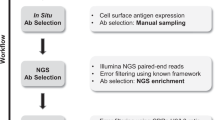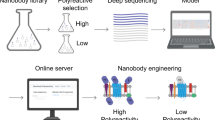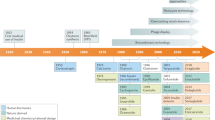Abstract
Although monoclonal antibody (mAb) drugs targeting protein interactions exist, these therapeutics cannot access intracellular proteins involved in disease complexes. Moreover, mAbs are more difficult to deliver and are frequently associated with a prohibitive 'royalty stack.' Outlined here is an alternative approach based on libraries of natural, highly structured peptides that offers new opportunities for identifying effective, specific inhibitors of protein-protein interactions. Libraries of such peptides (referred to hereafter as phylomers) comprise both random and structured peptides encoded by natural genes of diverse bacterial genomes. Because the number of protein subdomain structures found in nature is limited, diverse libraries containing millions of phylomers constitute virtually all of the available classes of protein fold structures, providing a rich source of peptides that interact specifically and with high affinity to human proteins. This approach may help not only in understanding the implications of each interaction identified within the interactome but also in the development of effective drugs targeted to particular protein functions. Although phylomers are active in animal models, the challenge remains to demonstrate efficacy and safety in a clinical setting.
This is a preview of subscription content, access via your institution
Access options
Subscribe to this journal
Receive 12 print issues and online access
$209.00 per year
only $17.42 per issue
Buy this article
- Purchase on Springer Link
- Instant access to full article PDF
Prices may be subject to local taxes which are calculated during checkout

Similar content being viewed by others
References
Pritchard, J.F. et al. Making better drugs: decision gates in nonclinical drug development. Nat. Rev. Drug Discov. 2, 542–553 (2003).
Bleicher, K.H., Bohm, H.J., Muller, K. & Alanine, A.I. Hit and lead generation: beyond high-throughput screening. Nat. Rev. Drug Discov. 2, 369–378 (2003).
Strosberg, A.D. Protein interaction mapping for target validation: the need for an integrated combinatory process involving complementary approaches. Curr. Opin. Mol. Ther. 4, 594–600 (2002).
Archakov, A. et al. Protein-protein interactions as a target for drugs in proteomics. Proteomics 3, 380–391 (2003).
Vassilev, L.T. Small-molecule antagonists of p53–MDM2 binding: research tools and potential therapeutics. Cell Cycle 3, 419–421 (2004).
Vassilev, L.T. et al. In vivo activation of the p53 pathway by small-molecule antagonists of MDM2. Science 303, 844–848 (2004).
Fischer, P. & Lane, D.P. Small-molecule inhibitors of the p53 suppressor HDM2: have protein-protein interactions come of age as drug targets? Trends Pharmacol. Sci. 25, 343–346 (2004).
Maroun, R.G. et al. Peptide inhibitors of HIV-1 integrase dissociate the enzyme oligomers. Biochemistry 40, 13840–13848 (2001).
Zhao, L., O'Reilly, M.K., Shultz, M.D. & Chmielewski, J. Interfacial peptide inhibitors of HIV-1 integrase activity and dimerization. Bioorg. Med. Chem. Lett. 13, 1175–1177 (2003).
Barr, R.K., Hopkins, R.M., Watt, P.M. & Bogoyevitch, M.A. Reverse two-hybrid screening identifies residues of JNK required for interaction with the kinase interaction motif of JNK-interacting protein-1. J. Biol. Chem. 279, 43178–43189 (2004).
Barr, R.K., Boehm, I., Attwood, P.V., Watt, P.M. & Bogoyevitch, M.A. The critical features and the mechanism of inhibition of a kinase interaction motif-based peptide inhibitor of JNK. J. Biol. Chem. 279, 36327–36338 (2004).
Kaneto, H. et al. Possible novel therapy for diabetes with cell-permeable JNK-inhibitory peptide. Nat. Med. 10, 1128–1132 (2004).
Borsello, T. et al. A peptide inhibitor of c-Jun N-terminal kinase protects against excitotoxicity and cerebral ischemia. Nat. Med. 9, 1180–1186 (2003).
Dasgupta, P. et al. Disruption of the Rb-Raf-1 interaction inhibits tumor growth and angiogenesis. Mol. Cell. Biol. 24, 9527–9541 (2004).
Chan, B., Greenan, G., McKeon, F. & Ellenberger, T. Identification of a peptide fragment of DSCR1 that competitively inhibits calcineurin activity in vitro and in vivo. Proc. Natl. Acad. Sci. USA 102, 13075–13080 (2005).
Stockton, R.A., Schaefer, E. & Schwartz, M.A. p21-activated kinase regulates endothelial permeability through modulation of contractility. J. Biol. Chem. 279, 46621–46630 (2004).
Kiosses, W.B. et al. A dominant-negative p65 PAK peptide inhibits angiogenesis. Circ. Res. 90, 697–702 (2002).
Park, S. & Raines, R. Genetic selection for dissociative inhibitors of designated protein/protein interactions. Nat. Biotechnol. 18, 847–851 (2000).
Colas, P. et al. Genetic selection of peptide aptamers that recognize and inhibit cyclin-dependent kinase 2. Nature 380, 548–550 (1996).
Xu, C. & Luo, Z. Inactivation of Ras function by allele-specific peptide apatamers. Oncogene 21, 5753–5757 (2002).
Vranken, W.F., James, S., Bennett, H.P. & Ni, F. Solution structures of a 30-residue amino-terminal domain of the carp granulin-1 protein and its amino-terminally truncated 3–30 subfragment: implications for the conformational stability of the stack of two beta-hairpins. Proteins 47, 14–24 (2002).
Adler, M. et al. The structure of a 19-residue fragment from the C-loop of the fourth epidermal growth factor-like domain of thrombomodulin. J. Biol. Chem. 270, 23366–23372 (1995).
Riechmann, L. & Winter, G. Novel folded protein domains generated by combinatorial shuffling of polypeptide segments. Proc. Natl. Acad. Sci. USA 97, 10068–10073 (2000).
Matthews, L., Davis, R. & Smith, G. Immunogenetically fit subunit vaccine components via epitope discovery from natural peptide libraries. J. Immunol. 169, 837–846 (2002).
Wolf, Y., Grishin, N. & Koonin, E. Estimating the number of protein folds and families from complete genome data. J. Mol. Biol. 299, 897–905 (2000).
Orengo, C., Michie, A., Jones, S., Swindells, M. & Thornton, J. CATH—a hierarchic classification of protein domain structures. Structure 5, 1093–1108 (1997).
Harrison, A. et al. Recognising the fold of a protein structure. Bioinformatics 19, 1748–1759 (2003).
Coulson, A. & Moult, J. A unifold mesofold and superfold model of protein fold use. Proteins 46, 61–71 (2002).
Chothia, C. Proteins. One thousand families for the molecular biologist. Nature 357, 543–544 (1992).
Zhang, C.-T. Relations of the number of protein sequences families and folds. Protein Eng. 10, 757–761 (1997).
Service, R. Structural genomics, round 2. Science 307, 1554–1557 (2005).
Koch, M. & Waldmann, H. Protein structure similarity clustering and natural product structure as guiding principles in drug discovery. Drug Discov. Today 10, 471–483 (2005).
Irback, A., Peterson, C. & Potthast, F. Evidence for nonrandom hydrophobicity structures in protein chains. Proc. Natl. Acad. Sci. USA 93, 9533–9538 (1996).
Pande, V.S., Grosberg, A.Y. & Tanaka, T. Nonrandomness in protein sequences: evidence for a physically driven stage of evolution? Proc. Natl. Acad. Sci. USA 91, 12972–12975 (1994).
Baud, F. & Karlin, S. Measures of residue density in protein structures. Proc. Natl. Acad. Sci. USA 96, 12494–12499 (1999).
Yang, A.S. & Honig, B. An integrated approach to the analysis and modeling of protein sequences and structures. III. A comparative study of sequence conservation in protein structural families using multiple structural alignments. J. Mol. Biol. 301, 691–711 (2000).
Nettles, K. & Greene, G. Ligand control of coregulator recruitment to nuclear receptors. Annu. Rev. Physiol. 67, 309–333 (2005).
Caponigro, G. et al. Transdominant genetic analysis of a growth control pathway. Proc. Natl. Acad. Sci. USA 95, 7508–7513 (1998).
Gudkov, A.V. et al. Cloning mammalian genes by expression selection of genetic suppressor elements: association of kinesin with drug resistance and cell immortalization. Proc. Natl. Acad. Sci. USA 91, 3744–3748 (1994).
Schmelzl, B. & Geli, M. An efficient genetic screen in mammalian cultured cells. EMBO Rep. 3, 682–687 (2002).
Parissi, V. et al. Functional interactions of human immunodeficiency virus type 1 integrase with human and yeast HSP60. J. Virol. 75, 11344–11353 (2001).
de Soultrait, V. et al. A novel short peptide is a specific inhibitor of human immunodeficiency virus type 1 integrase. J. Mol. Biol. 318, 45–58 (2002).
Parish, C.A. et al. Broad-spectrum antimicrobial activity of hemoglobin. Bioorg. Med. Chem. 9, 377–382 (2001).
Nibbering, P.H. et al. Human lactoferrin and peptides derived from its N terminus are highly effective against infections with antibiotic-resistant bacteria. Infect. Immun. 69, 1469–1476 (2001).
Kieffer, A. et al. The N- and C-terminal fragments of ubiquitin are important for the antimicrobial activities. FASEB J. 17, 776–778 (2003).
Short, J. Recombinant approaches for accessing biodiversity. Nat. Biotechnol. 15, 1322–1323 (1997).
Ladner, R.C. & Ley, A.C. Novel frameworks as a source of high-affinity ligands. Curr. Opin. Biotechnol. 12, 406–410 (2001).
Binz, H., Amstutz, P. & Pluckthun, A. Engineering novel binding proteins from nonimmunoglobulin domains. Nat. Biotechnol. 23, 1257–1268 (2005).
Szymkowski, D. Creating the next generation of protein therapeutics through rational drug design. Curr. Opin. Drug Discov. Devel. 8, 590–600 (2005).
Silverman, J. et al. Multivalent avimer proteins evolved by exon shuffling of a family of human receptor domains. Nat. Biotechnol. 23, 1556–1561 (2005).
Chirino, Ary, M.L. & Marshall, S. Minimizing the immunogenicity of protein therapeutics. Drug Discov. Today 9, 82–90 (2004).
Gonzales, N.R., De Pascalis, R., Schlom, J. & Kashmiri, S.V. Minimizing the immunogenicity of antibodies for clinical application. Tumour Biol. 26, 31–43 (2005).
Ernst, J.T., Becerril, J., Park, H.S., Yin, H. & Hamilton, A. Design and application of an α-Helix-mimetic scaffold based on an oligoamide-foldamer strategy: antagonism of the Bak BH3/Bcl-xL complex. Angew. Chem. Int. Ed. Engl. 42, 535–539 (2003).
Park, H.S., Lin, Q. & Hamilton, A. Modulation of protein-protein interactions by synthetic receptors: design of molecules that disrupt serine protease-proteinaceous inhibitor interaction. Proc. Natl. Acad. Sci. USA 99, 5105–5109 (2002).
Pazos, F. & Sternberg, M.J. Automated prediction of protein function and detection of functional sites from structure. Proc. Natl. Acad. Sci. USA 101, 14754–14759 (2004).
Bray, B. Large-scale manufacture of peptide therapeutics by chemical synthesis. Nat. Rev. Drug Discov. 2, 587–593 (2003).
Liu, S. et al. Different from the HIV fusion inhibitor C34, the anti-HIV drug Fuzeon (T-20) inhibits HIV1 entry by targeting multiple sites in gp41 and gp120. J. Biol. Chem. 280, 11259–11273 (2005).
Matthews, T. et al. Enfuvirtide: the first therapy to inhibit the entry of HIV-1 into host CD4 lymphocytes. Nat. Rev. Drug Discov. 3, 215–255 (2004).
Wheeler, D. et al. Safety, tolerability, and plasma pharmacokinetics of high-strength formulations of enfuvirtide (T-20) in treatment-experienced HIV-1-infected patients. J. Clin. Virol. 30, 183–190 (2004).
Rappocciolo, E. Antimicrobial peptides as carriers of drugs. Drug Discov. Today 9, 470 (2004).
Cudic, P. et al. Complexation of peptidoglycan intermediates by the lipoglycodepsipeptide antibiotic ramoplanin: minimal structural requirements for intermolecular complexation and fibril formation. Proc. Natl. Acad. Sci. USA 99, 7384–7389 (2002).
Cudic, M. et al. Development of novel antibacterial peptides that kill resistant isolates. Peptides 23, 2071–2083 (2002).
Cudic, M., Ertl, H.C. & Otvos, L., Jr. Synthesis, conformation and T-helper cell stimulation of an O-linked glycopeptide epitope containing extended carbohydrate side-chains. Bioorg. Med. Chem. 10, 3859–3870 (2002).
Cudic, M., Lockatell, C.V., Johnson, D.E. & Otvos, L., Jr. In vitro and in vivo activity of an antibacterial peptide analog against uropathogens. Peptides 24, 807–820 (2003).
Cudic, M. & Otvos, L., Jr. Intracellular targets of antibacterial peptides. Curr. Drug Targets 3, 101–106 (2002).
Cudic, P. et al. Functional analysis of the lipoglycodepsipeptide antibiotic ramoplanin. Chem. Biol. 9, 897–906 (2002).
Lewis, R. & Garcia, M. Therapeutic potential of venom peptides. Nat. Rev. Drug Discov. 2, 790–802 (2003).
Acknowledgements
I am grateful to Wayne Thomas, Prue Hart, John Finlay-Jones, Patrick Holt, Rob Aalberse, Vanessa Cull, Mark Fear, Richard Hopkins, Nadia Milech Graham Robertson, Frank Sotzik and laboratory colleagues for assisting with review of the manuscript. The assistance of Graham Carter (Accuro Biologics Ltd) in conducting the bioinformatics analysis of potential for immunogenicity of phylomer peptides is also gratefully acknowledged.
Author information
Authors and Affiliations
Corresponding author
Ethics declarations
Competing interests
P.W. is the scientific director of Phylogica, Ltd., the company that is commercializing the Phylomer technology. P.W. holds both shares and stock options in this company, which is publicly listed on the Australian Stock Exchange (ASX:PYC). This holding amounts to less than 5% of issued capital.
Supplementary information
Rights and permissions
About this article
Cite this article
Watt, P. Screening for peptide drugs from the natural repertoire of biodiverse protein folds. Nat Biotechnol 24, 177–183 (2006). https://doi.org/10.1038/nbt1190
Published:
Issue Date:
DOI: https://doi.org/10.1038/nbt1190
This article is cited by
-
Learn from antibody–drug conjugates: consideration in the future construction of peptide-drug conjugates for cancer therapy
Experimental Hematology & Oncology (2022)
-
Discovery of antimicrobials by massively parallelized growth assays (Mex)
Scientific Reports (2022)
-
Tumor penetrating peptides inhibiting MYC as a potent targeted therapeutic strategy for triple-negative breast cancers
Oncogene (2019)
-
A platform for discovery of functional cell-penetrating peptides for efficient multi-cargo intracellular delivery
Scientific Reports (2018)
-
Zebrafish as a model to evaluate peptide-related cancer therapies
Amino Acids (2017)



